Wintering Shorebirds on San Francisco Bay
By Maureen Lahiff
Spring is almost here, but there’s still time to enjoy the shorebirds that are here for winter R&R. Many of the species that winter in large numbers on San Francisco Bay have come a long way on their fall migration. They spend the summer nesting in a wide diversity of habitats, from the high Arctic and sub-Arctic, to the forests of Alaska and across northern Canada, and across the Great Basin and the Great Plains.
Shorebirds are drawn here for the winter by our climate; our shorelines bordered by marsh plants; and the large variety of invertebrates and small shellfish that make their homes in the mudflats and intertidal zones bordering the Bay, thriving in the Bay’s mix of salt and fresh water, referred to as “brackish.”
The miracle of wetlands
Although we’ve lost 90% of the wetlands that ringed the Bay before 1850, what’s left still provides a smorgasbord for shorebirds. The food chain is driven by microscopic organisms, phytoplankton and zooplankton, which are consumed by invertebrates and tiny fish.
Conservation efforts by a number of organizations including Golden Gate Bird Alliance have led to improved habitat for shorebirds. At the same time, restoring wetlands provides a buffer against sea level rise.
What is a shorebird?
Not all birds at the shore are shorebirds, and not all shorebirds are found close to water. The essential characteristic of shorebirds is that they feed by picking and probing with their bills. Some hunt by sight, while others with longer bills probe in the mud and the bay floor, hunting by touch and smell.
When you see a number of shorebirds feeding together, notice how their different sizes and bill lengths allow them to use slightly different niches in the same habitat, so that they are not directly competing for the same food resources.
Shorebirds are also notable for their long legs: The Brits call them “waders”!
Some great birds to get you started
Shorebird watching is rewarding for beginning birders and children, as many species are easy to see when feeding along the shoreline. Unless disturbed, they walk or wade while searching for food, so you can get a leisurely look. It’s helpful to have binoculars, but you don’t necessarily need a spotting scope. If you don’t want to carry a field guide, consider the “Beach and on the Bay ” foldout guide in John Muir Laws’s The Laws Pocket Guide Set: San Francisco Bay Area.
Here are some common and distinctive-looking shorebirds to start with. These are our larger shorebirds, which are easier for beginners to identify than the numerous tiny “peeps” or sandpipers that you’ll also see. For just about every species, female and male shorebirds have very similar appearances, especially in the winter:
Long-billed Curlew: The largest North American shorebird is famous for its very long, downcurved bill. Its back and side feathers are a mix of warm peachy tones, along with brown and white, and its belly is solidly a warm peachy color. The combination of long legs and a very long bill allow the Long-billed Curlew to reach food no other shorebird can get. Its smaller cousin, the Whimbrel, is a study in shades of brown and white, with distinct head stripes. The Whimbrel also has a downcurved bill, but it is relatively shorter and less sharply curved. In most Bay Area locations, Whimbrels are less common than Long-billed Curlews.
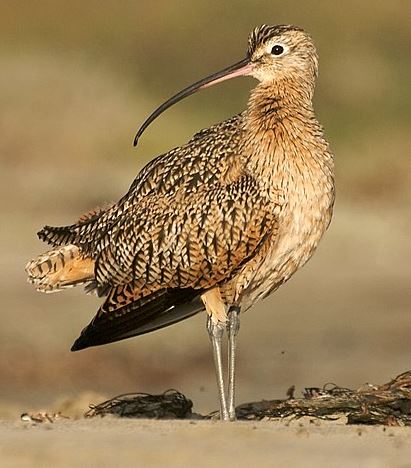

Marbled Godwit: This bird has a distinctly two-toned bill. The basal half nearer its head is pink, and the lower part is black. (A lot of shorebirds have a bit of pink at the base of their bills, but only a godwit has pink on half of its bill.) The Marbled Godwit’s overall coloration is also a warm peach. But its bill color and shape (almost straight, with a slight upturn) distinguishes it from the Long-billed Curlew, and it is also slightly smaller than a Long-billed Curlew.
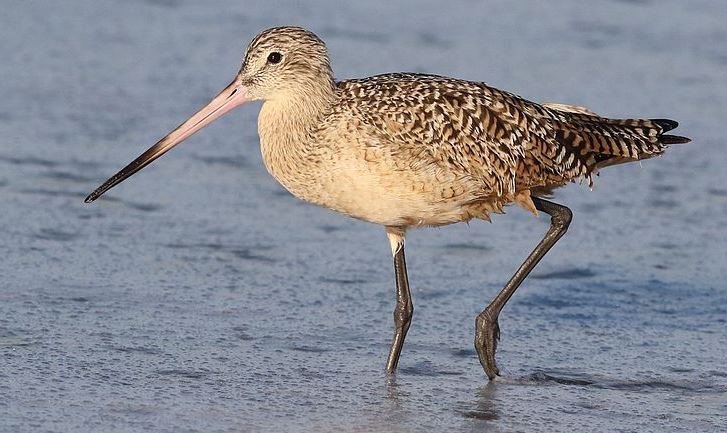
Willet: In the winter, Willets are a study in gray – gray head and back, gray folded wings, gray legs with a long, darker bill. When they fly, Willets display a broad white stripe on their wings. They’re smaller than Marbled Godwits, with whom they often feed and hang out.
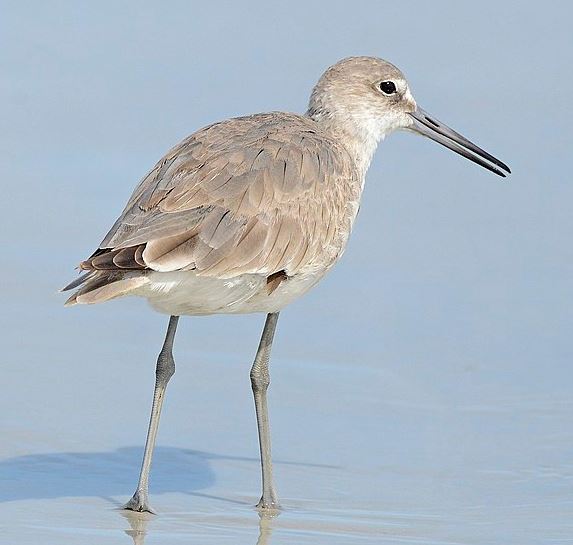
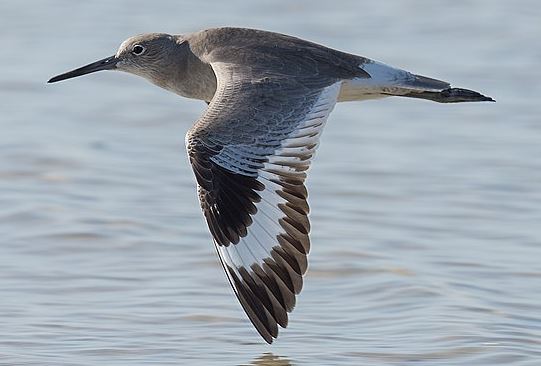
Black-bellied Plover: Plovers are stocky, with short necks. Black-bellied Plovers have large black eyes, stubby black bills, and black legs. This bird is called the Grey Plover in the rest of the world, and when you see Black-bellied Plovers in the winter, you can understand why. Black-bellied Plovers do have black bellies, flanks, throats, necks, and faces—but only in their summer breeding plumage. If you see them on the Bay in September, many still have some black belly feathers.
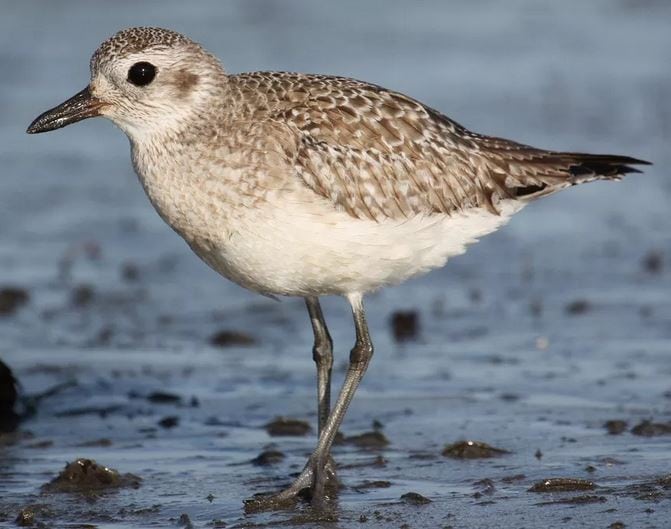
American Avocet: Some Avocets nest in the Bay Area, but there are many more here in the winter. Avocets have upturned bills. Distinctively patterned in black and white in the winter, both the females and males have rich cinnamon feathers on their necks and heads in spring and summer. Avocets swim as well as walk and wade. They feed in a variety of ways, but their most distinctive behavior is sweeping their bills side-to-side through the water in a motion called scything.
Black-necked Stilt: These tall, slender shorebirds have long bubble-gum pink legs and tuxedo-like coloring. Their necks are black and white; their faces are patterned in black and white; their backs and wings are black, and their bellies are white.

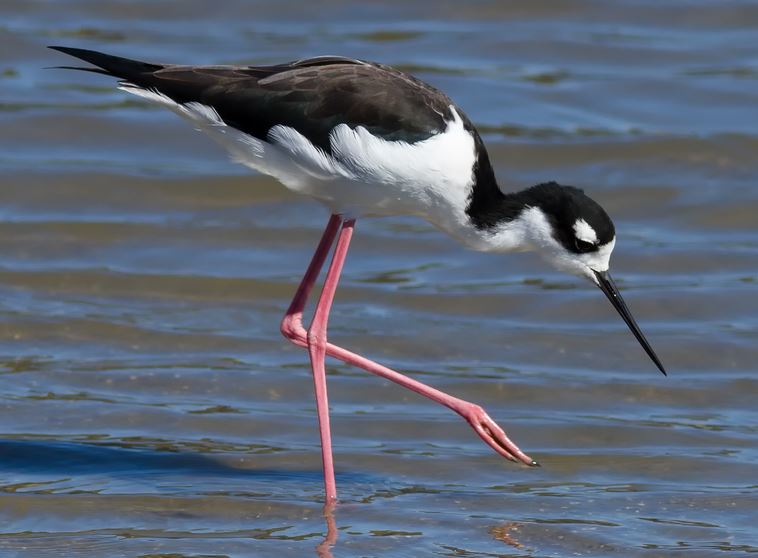
Other water birds: Although not classified as shorebirds, Great Blue Herons, Great Egrets, and Snowy Egrets are other spectacular birds that frequent the Bay shore in the winter, along with Brown Pelicans.
When and where to look for shorebirds
Shorebirds live by the tides. A web search with the keywords “NOAA Tide Predictions” and the names of the places listed below can give you a daily graph of high and low tides. On S.F. Bay, there are two high tides and two low tides every day. Because of the way the moon rotates around the Earth, tides have a cycle that is about 50 minutes longer than 24 hours, so the high tide is about 50 minutes later from day to day. Tides are more extreme near the new moon and full moon, and in December and January, when the Earth is closest to the Sun in its orbit.
Many shorebirds will be actively feeding as the high tide goes out. When the tide chart shows a water level of 5 or 5.5 feet, there is usually enough mudflat exposed, but the shorebirds will still be fairly close to shore—an ideal time for viewing.
Good places to look for shorebirds
Elsie Roemer Bird Sanctuary at the southeast end of Crown Beach in Alameda.
Middle Harbor Shoreline Park at the end of 7th Street in Oakland.
Garretson Point and around Arrowhead Marsh at Martin Luther King Jr. Regional Shoreline in Oakland.
Emeryville near the end of Powell Street, by the fire house and on the walking paths.
Berkeley’s César E Chávez Park. Park along Marina Way and walk along the Virginia Street Extension trail.
Albany at the foot of Buchanan Street, where there’s parking for the Albany Waterfront Trail.
Hayward Regional Shoreline in Fremont. Walk north along the Bay Trail from the Winton Ave parking lot to a high tide roost popularly called Frank’s Dump.
Point Isabel Regional Shoreline, along the S.F. Bay Trail, and north to Hoffman Marsh, Meeker Slough. and Shimada Friendship Park.
More about shorebirds
Learn more about all these species at the Cornell Lab of Ornithology’s allaboutbirds.org website.
Maureen Lahiff teaches Golden Gate Bird Alliance’s adult education class on Waterbirds and Shorebirds in Winter. She participates in local shorebird and waterbird counts, and looks forward to again leading GGBA shorebird field trips once public health guidelines permit, possibly as soon as August 2021.
